Language and Maps
I have been going through our old “View”s (the artist interviews that
By coincidence, in conversation over lunch the other day a friend brought up that theory again. We were talking about the importance of education, especially vocabulary. “Vocabulary and intelligence go hand-in-hand,” he was saying. “You can have the best ideas in the world, but if you can’t articulate them, no one will know.” His idea of intelligence reminds me of the old question, of the tree in the forest no one hears fall: if your ideas cannot be told, are they really there?
We have customs and sayings to keep us all in some sort of agreement. From phrases to metaphors, names to numbers, verbs to adjectives, all of language is a symbolic map of our thoughts. Language allows us to tell each other, in a million different ways, who we are, where we’re going, how we see, and what we stand for. (“I am happy,” you might say to a stranger, and the stranger, knowing absolutely nothing about what makes you happy or what happiness is to you, will have some idea of what you mean.) But if language is a map of concepts, concepts themselves are like the constantly evolving surface of the territory a map describes. We call concepts by name for the same reason we plot the shifting, quaking crust of the earth into countries and regions: for everyone’s convenience. From ‘irony’ to ‘delicious’ to ‘art’ to ‘fun,’ concepts are colored differently for everyone, but for the sake of getting on with things, we all agree on a general region of truth for each one. Most of us share this mental map, where, say, ‘fun’ and ‘getting kicked in the teeth’ do not live on the same continent. (Those who don’t share it are probably lost.)
everyone, but for the sake of getting on with things, we all agree on a general region of truth for each one. Most of us share this mental map, where, say, ‘fun’ and ‘getting kicked in the teeth’ do not live on the same continent. (Those who don’t share it are probably lost.)
In some ways, then, the function of the artist is to be a sort of conceptual cartographer. The artist explores an idea past the limits of language, only to bring it back again. Some change our landscape by offering us new maps and with them new ways of looking at it. Christopher Brown, who calls painting itself a “complex language,” and says “I was playing around with what things could possibly mean and how paintings could contradict each other,” is a good example of one of these. Others, like Marcel Duchamp, who famously stuck a bicycle wheel in a gallery and called it art, change our maps by making earthquakes in the very surface they describe. On the map Duchamp made, the country of ‘art’ took over the provinces of ‘bicycle wheel,’ ‘pipe’ and ‘urinal,’ and world never looked quite the same.
- Rachel Lyon
